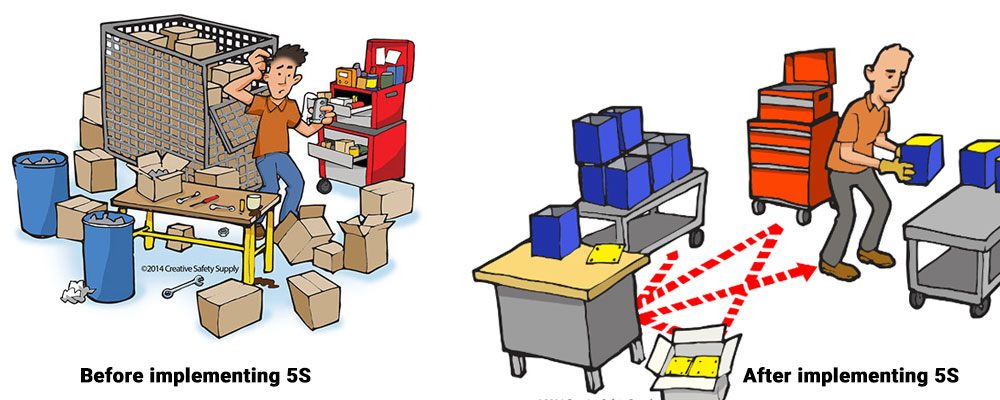Basically 5S is a philosophy and an approach of organizing and managing the workplace and course of work with the commitment of increasing efficiency by reducing waste, enhancing flow and decreasing process irrationality. It uses a list of five Japanese words: Seiri (Sort) Seiton (Set in Order), Seiso (Shine), Seiketsu (Standardize), and Shitsuke (Sustain). 5S symbolizes 5 disciplines in order to preserve a visual workplace.
5S Workplace Organization and Standardization
Seiri/Sort
The first step in 5S workplace organization and standardization emphasizes on reducing unneeded items from the workplace. Here the equipment, furniture and tool in workplace are categorized into the 3 categories which are necessary, unnecessary and may not be necessary. Moreover, this step can also be beneficial with the “just in case” approach. Industrial bins are required for an exact class. On the basis of the standard method, three to four “bins” or organizing sorts are used when performing a 5S category that comprises of keep, remove, probation and to move. It is a key point to audit the categorization process dynamically of any 5S’d space to make sure precision and focus. At times, a focus on organization can dominate further main areas so it must be ensured to register on tool standardization, expiration dates of supply, and possible safety risks while areas are going through audit organization.
Seiton/Set in Order
The term “Set” is based on determining efficient and effective storage of essential articles. It uses the idea of “can see, can take out, and can return”. By following this philosophy time and energy can be saved when we want to find something. An effective approach to initiate this step is to plan the space where the tools and equipment will be going back to. It is very important to truly consider the jobs being done in or around every station during this stage. This approach must be used to design the most suitable and easy areas for employees to go. Furthermore, employees’ most commonly used tools must be located in convenient and easily accessible areas with the minimum possible limitations.
Seiso/Shine
This step means cleaning up the workplace on every day basis with the intention of having no dust on floors, machines or tools. By following this approach ownership can be created and pride can be built among the workers. Approximately in any case, there is no doubt that an uncontaminated workplace is a safer place of work. For example, when the floors are maintained clear of dirt and residues it facilitates to lessen the hazard of tours, slips, and falls which are a very common source injuries in the workplace. It is useful to post images in the proximate areas displaying the entirely cleaned or “shined” workplace condition. It can be a useful approach to have this communication successful even when nobody is actually around to provide it. Likewise, an information board can also be used which illustrates step-by-step guidelines for cleaning specific areas or equipment’s.
Seiketsu/Standardize
An essential bridge between Shine and the last step of 5S is to standardize. By systematizing the method to 5S through standardization, it can be confirmed that organizational efforts are continued in due course through a sustainable approach. If an organization fails to standardize work processes then it can cause disordered and inefficient work over time. It is helpful to give employees opportunities to play a dynamic role in the standards development. An outstanding technique to accomplish this is to plan and print out 5S sheets of audit that can be used by anyone who is examining an area on a particular day.
Shitsuke/Sustain
The last step of 5S workplace organization and standardization is called Sustain or Shitsuke which concentrates on covering every former step of 5S, with the standardized processes, and converting them into continuing practices to guarantee continuous improvement. It addresses describing a new outlook and a standard in place of work. It must be kept in mind that anything anticipated from workers must be shown properly by a qualified and experienced professional. Additionally, employees must be observed in their first efforts to check the 5S daily routines that are being made are the precise practices required and looked-for. More to the point, mistakes must be fixed. Occasionally continuous unwanted behavior or unwanted outcomes occur as a result of a defective system. In that case, the fault must be found in the actual system and it must be corrected as necessary.






